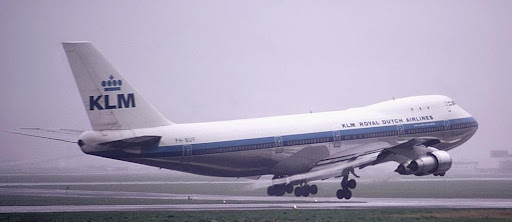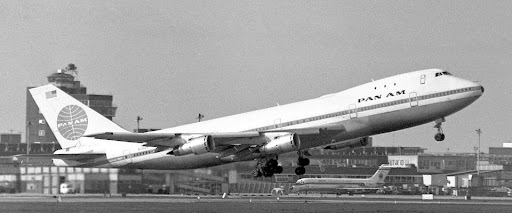The worst accident in aviation history occurred 32 years ago, on March 27th, 1977, on the island of Tenerife, part of the Spanish Canary Islands in the North Atlantic Ocean.
Several aircraft were diverted to Tenerife because of a bombing at Las Palmas Airport, their original destination on Gran Canaria island. The Tenerife airport had only one runway, and limited apron space, so the visiting aircraft were forced to park on the taxiway as well. After an extended delay, during which heavy fog enveloped the airfield, the first aircraft ready for departure were instructed to taxi to the end of the runway, move down its length, and do a U-turn to point back into the wind for take-off. (The taxiway, remember, was occupied by other, parked aircraft.) The first aircraft to move, a KLM Boeing 747, did this, and waited at the end of the runway. Meanwhile, a Pan Am Boeing 747 was moving down the runway, having been instructed to take the third turnoff and wait there until the KLM aircraft had taken off.

KLM Boeing 747, registration PH-BUF, destroyed at Tenerife (click to enlarge)
Unfortunately, the evidence suggests that the KLM pilot was impatient and rather arrogant in his approach to his crew and the airport authorities. Without proper authorization, he released his brakes and began his takeoff run - while the Pan Am jet was still taxiing towards him, having missed its turnoff point. In the fog, neither aircraft could see the other until it was too late.

Pan Am Boeing 747, registration N736PA, destroyed at Tenerife (click to enlarge)
In the words of the surviving First Officer of the Pan Am aircraft, Robert L. Bragg:
We were looking very hard for our taxiway on the left so we could depart the runway. As we began to see the taxiway we were looking for, I looked up and saw the nose of the KLM B-747. This was not immediately surprising as we knew the plane was there, supposedly waiting for us to depart the runway. I then noticed his landing lights shaking and very excitedly said, ‘I think he’s moving’. It was then very obvious that he in fact was moving at a very rapid rate directly toward us. I started yelling, ‘GET OFF, GET OFF!’ The captain had made the same decision at exactly the same time I shouted.
He immediately applied full power and turned the plane hard left. We were told later the plane turned about 27 degrees to the left before being hit by the KLM B-747. The captain, by his quick action, saved the Pan Am crew and the few passengers who survived the crash.
As we were turning left, I looked back to my right out of the cockpit’s right hand window. I couldn’t believe what I was seeing – that the KLM B-747 was actually taking off. In a second or two, the KLM plane had rotated and the entire fuselage had lifted off the runway. The last thing I remember seeing was the red rotating beacon on the bottom of the fuselage.
I ducked, closed my eyes, and prayed, ‘God, let him miss us…’ When it did hit our plane, it was only a very short, quiet shudder. I actually thought that he had, in fact, missed us – until I opened my eyes. The first thing I noticed was that all of the windows in the cockpit windshield were completely and totally gone. I looked to the right and saw that the right wing was totally engulfed in flames.
I looked to the left and saw that the entire upstairs lounge and its 28 passengers were gone. The cockpit floor and upstairs lounge floor were also gone. I could see all of the way to the very rear of the cabin of the plane. I have always thought that it looked as if someone with a giant knife had simply cut the entire top of the cabin off.
I immediately looked and reached up to pull the fire-control handles which shut down the engines in addition to accomplishing several other functions. After I noticed that the entire top of the cockpit was missing, I reached down and shut off all four of the engines’ start levers. Nothing happened. The engines were operating at full throttle prior to our being hit, and they continued to operate the same way after the impact – at full power. I again started yelling, ‘Get out, get out!’
At that point, I decided it was time to heed my own call and get out of the cockpit. When I stood up, there was only about a foot of the cockpit floor still in place. I stood on that and, facing left, held on to the back of the captain’s seat, placed my foot onto the cockpit side and, without even thinking of the distance to the ground – which was about forty-eight feet – I jumped.
It was an awfully long way to the ground. I really think I’m the only crewmember ever to have actually jumped from a B-747 cockpit to the ground, and I sincerely hope I continue to hold that record forever.
. . .
When I hit the ground, I hit on grass. The very last thing I remember hearing prior to our being hit was the planes nose gear dropping off the runway unto the grass. I did the same. Landing on grass was very lucky for me. I’m sure if I had landed on the cement that I would have broken a lot of bones.
I immediately looked back at the plane and it was burning furiously, especially the section over the central fuel tank. What was most surprising was that a large number of passengers had made their way out onto the left wing of the plane.
I also remember that the engines were still running at full power when I went back up to the plane, as close as I could get, and started waving and yelling to the passengers to jump off the wing, as I expected the entire plane to explode at any minute. All of the passengers did as I had hoped. They jumped from the wing – which was about 25 feet above the ground.
I saw one male passenger running as fast as he could, dragging a lady by the ankle. I found out later that the woman was his wife and that she had broken both legs, both arms, as well as her back when she jumped from the wing. She had been among the first to jump and nearly everyone behind her landed on top of her when they jumped.
All during this time, I was motioning for the passengers to get as far away from the plane as they could. At one point I stopped to see what I thought were passengers coming back up to the plane and I wondered why in the world they were doing that. Then, I stopped and took a better look. I soon realised that these people were local inhabitants, whose homes were located near the airport, who had voluntarily came out to the crash site to assist in any way they could.
Of the Pan Am passengers, sixty-five managed to survive the crash, as did the three cockpit crewmembers, four flight attendants, and two Pan Am staff members who were in the cockpit. No one in the KLM plane survived. When it hit us, the plane severed its landing gear, exploded, and crashed back to the runway some 1500 feet beyond our plane. The total loss of life was 583 people.
A memorial stands on Tenerife today to commemorate those who died.

Let's remember them in our prayers - and those who survived them, and will be mourning them on this very sad anniversary.
Peter
1 comment:
i think that this accident is a moral to all pilots.
Post a Comment